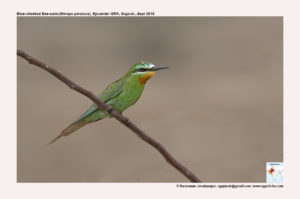
Blue-cheeked Bee-eater Merops persicus
Etymology:
- Merops : Greek word for Bee-eater
- Persicus: From Persia
Vernacular Name: Baluchistan: Kurru, Haur murgh, Sind: Wado traklo, Hindi: Bada patringa, Guj: Moto patrangiyo, Kutch: Bada hajamda, Mar: Nilya galacha veda raghu
Distribution in India: Passage migrant in North West India.
Description: Size of 31 cm (with streamers, up to 7 cm more); weight of 38–56 g. It is a large, slim bee-eater with long wings. The male of nominate race has upperparts grass-green in fresh plumage, wings and tail are more golden-green, sometimes all parts except rump are quite strongly olive; with bleaching or wear turns more bluish, particularly on tertials and rump. The wings have narrow, dusky trailing edge; forehead is narrowly white by bill, shading backwards to powder-blue. In immature birds, forehead is yellowish and blue eyebrow poorly developed; broad black eye band; cheeks are broadly blue but may be narrowly white; chin is bright yellow, sometimes dull yellow; throat are rufous, underparts are bright green; axillaries and entire underwing except distal halves of flight-feathers are russet. The bill is long and slender and black; iris is claret. The female is like male, but tail-streamers are shorter, iris is orange-red. The juvenile is olive-green above except for blue-green rump and ochre tinge on nape; head and body are markedly scaly, feathers are narrowly white-fringed; forehead is narrowly buffy, eyebrow is yellowish-buff; chin is pale buff, washed yellow; throat is warm buff, yellower or white towards cheeks; breast are pale green, scaly; undertail-coverts are very pale green; moults directly into adult plumage 4–5 weeks after fledging.
Habitat: It is found in desert, semi-desert, steppe, dunes, saline pans, cultivation, thorn woodland and sandy slopes with small gulleys, ravines, quarries, pits and embankments. It breeds mainly in sand deserts near bodies of water fringed with reeds and tamarisks. During non-breeding season, inhabits a wide variety of greener habitats, savanna, broad river valleys, woods, lakeshores, swamps, ponds, dams, waterworks and cultivation. It is found below 2400 m.
Food habits: It eats mainly hymenopterans, dragonflies, honeybees, beetles, locusts and cicadas. It feeds by making long pursuit-flights from telephone wires, fences, treetops, even from ground; makes height with fast, even wing beats, glides, then twists abruptly after its prey; some wasps are seized from below, with bird’s head thrown back and its bill pointing straight up. It returns to perch to knock prey and, if hymenopteran, to rub its tail. Often forages in continuous flight; occasionally follows moving vehicle to catch insects dislodged from grass.
Breeding habits: They breed in Mar–Jun. They are monogamous. They nest in solitary or in loose colonies .The nest is a tunnel excavated on bank of canal or irrigation ditch, seashore, low cliff of compacted, wind-scoured sand dune, hard-baked sandy mud plain or large, enclosed pasture, also in earthen shoulder of metalled road, burrow then extending beneath tarmac; excavates in level, sandy ground, slope, declivity face or cliff. They lay a clutch of 4–8 eggs, laid at 1-day intervals. The eggs are incubated by both parents by day, by female alone at night. The incubation starts with first egg for a period of 23–26 days. The nestling period is 30 days.